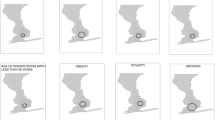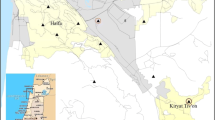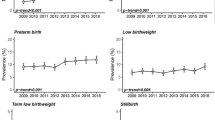Abstract
Health effects of close residential proximity to nuclear facilities have been a concern for both the general public and health professionals. Here, a study is reported examining the association between maternal residential proximity to nuclear facilities and low birth weight (LBW) in offspring using data from 1996 through 2008 in Texas, USA. A case–control study design was used together with a proximity-based model for exposure assessment. First, the LBW case/control births were categorized into multiple proximity groups based on distances between their maternal residences and nuclear facilities. Then, a binary logistic regression model was used to examine the association between maternal residential proximity to nuclear facilities and low birth weight in offspring. The odds ratios were adjusted for birth year, public health region of maternal residence, child’s sex, gestational weeks, maternal age, education, and race/ethnicity. In addition, sensitivity analyses were conducted for the model. Compared with the reference group (more than 50 km from a nuclear facility), the exposed groups did not show a statistically significant increase in LBW risk [adjusted odds ratio (aOR) 0.91 (95% confidence interval (CI): 0.81, 1.03) for group 40–50 km; aOR 0.98 (CI 0.84, 1.13) for group 30–40 km; aOR 0.95 (CI 0.79, 1.15) for group 20–30 km; aOR 0.86 (CI 0.70, 1.04) for group 10–20 km; and aOR 0.98 (CI 0.59, 1.61) for group 0–10 km]. These results were also confirmed by results of the sensitivity analyses. The results suggest that maternal residential proximity to nuclear facilities is not a significant factor for LBW in offspring.

Similar content being viewed by others
Notes
Although g and kg are the unit of “mass”, in this paper the term “weight” is preferred to keep consistency with the pertinent literature.
References
Altman DG, Bland JM (1995) Statistics notes: absence of evidence is not evidence of absence. BMJ 311(7003):485
Canfield MA, Ramadhani TA, Langlois PH, Waller DK (2006) Residential mobility patterns and exposure misclassification in epidemiologic studies of birth defects. J Expo Sci Environ Epidemiol 2006(16):538–543
Currie J, Zivin JG, Meckel K, Neidell M, Schlenker W (2013) Something in the water: contaminated drinking water and infant health. Can J Econ 46(3):791–810
Dadvand P, Sunyer J, Basagana X, Ballester F, Lertxundi A, Fernandez-Somoano A, Estarlich M, Garcia-Esteban R, Mendez MA, Nieuwenhuijsen MJ (2012) Surrounding greenness and pregnancy outcomes in four Spanish birth cohorts. Environ Health Perspect 120(10):1481–1487
Dias CM, Telles EC, Santos RV, Stenstrom K, Nicoli IG, da Silveira Corrêa R, Skog G (2009) C-14, delta C-13 and total C content in soils around a Brazilian PWR nuclear power plant. J Environ Radioact 100(4, SI):348–353
Ebisu K, Belanger K, Bell ML (2008) Air pollution effects on birth weight in Connecticut and Massachusetts. Epidemiology 19(6):S108
Glinianaia SV, Rankin J, Bell R, Pless-Mulloli T, Howel D (2004) Particulate air pollution and fetal health a systematic review of the epidemiologic evidence. Epidemiology 15(1):36–45
Hales CN, Barker DJ (1992) Type 2 (non-insulin-dependent) diabetes mellitus: the thrifty phenotype hypothesis. Diabetologia 35(7):595–601
Huang L, Zhou Y, Han Y, Hammitt JK, Bi J, Liu Y (2013) Effect of the Fukushima nuclear accident on the risk perception of residents near a nuclear power plant in China. Proc Natl Acad Sci USA 110(49):19742–19747
Ilyinskikh NN, Ilyinskikh IN, Shakirov NN, Smirnov BV, Ilyinskikh EN (2000) Monitoring of radiation-exposed people close to Mayak nuclear facility in the Chelyabinsk region (Russia) using different biodosimetric methods. Environ Monit Assess 61(3):345–359
Joseph KS, Kramer MS (1996) Review of the evidence on fetal and early childhood antecedents of adult chronic disease. Epidemiol Rev 18(2):158–174
Kaatsch P, Spix C, Jung I, Blettner M (2008) Childhood leukemia in the vicinity of nuclear power plants in Germany. Dtsch Arztebl Int 105(42):725–732
Laurent O, Wu J, Li L, Milesi C (2013) Green spaces and pregnancy outcomes in Southern California. Health Place 24:190–195
Lawlor DA, Ronalds G, Clark H, Davey Smith G, Leon DA (2005) Birth weight is inversely associated with incident coronary heart disease and stroke among individuals born in the 1950s: findings from the Aberdeen children of the 1950s prospective cohort study. Circulation 112(10):1414–1418
Lupo PJ, Symanski E, Chan W, Mitchell LE, Waller DK, Canfield MA, Langlois PH (2010) Differences in exposure assignment between conception and delivery: the impact of maternal mobility. Paediatr Perinat Epidemiol 24(2):200–208
Maisonet M, Correa A, Misra D, Jaakkola JJK (2004) A review of the literature on the effects of ambient air pollution on fetal growth. Environ Res 95(1):106–115
Mangones T, Visintainer P, Brumberg HL (2013) Congenital anomalies, prematurity, and low birth weight rates in relation to nuclear power plant proximity. J Perinat Med 41(4):429–435
Mettler FA, Williamson MR, Royal HD, Hurley JR, Khafagi F, Sheppard MC, Beral V, Reeves G, Saenger EL, Yokoyama N (1992) Thyroid nodules in the population living around Chernobyl. JAMA 268(5):616–619
Morris MS, Knorr RS (1996) Adult leukemia and proximity-based surrogates for exposure to pilgrim plant’s nuclear emissions. Arch Environ Health 51(4):266–274
Osmond C, Barker D (2000) Fetal, infant, and childhood growth are predictors of coronary heart disease, diabetes, and hypertension in adult men and women. Environ Health Perspect 108(suppl 3):545–553
Queisser-Luft A, Wiesel A, Stolz G, Mergenthaler A, Kaiser M, Schlaefer K, Wahrendorf J, Blettner M, Spix C (2011) Birth defects in the vicinity of nuclear power plants in Germany. Radiat Environ Biophys 50(2):313–323
Reynolds P, Urayama KY, Von Behren J, Feusner J (2004) Birth characteristics and hepatoblastoma risk in young children. Cancer 100(5):1070–1076
Ritz B, Wilhelm M (2008) Ambient air pollution and adverse birth outcomes: methodologic issues in an emerging field. Basic Clin Pharmacol Toxicol 102(2):182–190
Scherb H, Voigt K (2011) The human sex odds at birth after the atmospheric atomic bomb tests, after Chernobyl, and in the vicinity of nuclear facilities. Environ Sci Pollut Res Int 18(5):697–707
Sharp L, Black RJ, Harkness EF, McKinney PA (1996) Incidence of childhood leukaemia and non-Hodgkin’s lymphoma in the vicinity of nuclear sites in Scotland, 1968–1993. Occup Environ Med 53(12):823–831
Slama R, Boutou O, Ducot B, Spira A (2008) Reproductive life events in the population living in the vicinity of a nuclear waste reprocessing plant. J Epidemiol Community Health 62(6):513–521
Spix C, Schmiedel S, Kaatsch P, Schulze-Rath R, Blettner M (2008) Case–control study on childhood cancer in the vicinity of nuclear power plants in Germany 1980–2003. Eur J Cancer 44(2):275–284
Srám RJ, Binková BB, Dejmek J, Bobak M (2005) Ambient air pollution and pregnancy outcomes: a review of the literature. Environ Health Perspect 113(4):375–382
Talge NM, Mudd LM, Sikorskii A, Basso O (2014) United States birth weight reference corrected for implausible gestational age estimates. Pediatrics 133(5):844–853
U.S. CDC (United States Centers for Disease Control and Prevention) (2012) Low birthweight and the environment. http://ephtracking.cdc.gov/showRbLBWGrowthRetardationEnv.action [updated 2014; last accessed November 2015]
U.S. CDC (United States Centers for Disease Control and Prevention) (2014) Reproductive and birth outcomes. http://ephtracking.cdc.gov/showRbMain.action [updated 2014; last accessed November 2015]
U.S. CDC (United States Centers for Disease Control and Prevention) (2015) Reproductive health—maternal and infant health. http://www.cdc.gov/reproductivehealth/maternalinfanthealth/pregcomplications.htm [updated 2015; last accessed November 2015]
US Census Bureau (2010) 2010 Census summary file 1. US Census Bureau, Washington, DC
U.S. Census Bureau (2015) State & County QuickFacts. http://quickfacts.census.gov/qfd/states/48000.html [updated 2015; last accessed August 2015]
U.S. NRC (United States Nuclear Regulatory Commission) (2015a) Nuclear reactors: power reactors. http://www.nrc.gov/reactors/power.html [updated 2015; last accessed November 2015]
U.S. NRC (United States Nuclear Regulatory Commission) (2015b). Nuclear reactors: research & test reactors. http://www.nrc.gov/reactors/non-power.html [updated 2015; last accessed November 2015]
Valero De Bernabé J, Soriano T, Albaladejo R, Juarranz M, Calle ME, Martínez D, Domínguez-Rojas V (2004) Risk factors for low birth weight: a review. Eur J Obstet Gynecol Reprod Biol 116(1):3–15
Villanueva CM, Durand G, Coutté M-B, Chevrier C, Cordier S (2005) Atrazine in municipal drinking water and risk of low birth weight, preterm delivery, and small-for-gestational-age status. Occup Environ Med 62(6):400–405
Wang S-I, Lee L-T, Zou M-L, Fan C-W, Yaung C-L (2010) Pregnancy outcome of women in the vicinity of nuclear power plants in Taiwan. Radiat Environ Biophys 49(1):57–65
Wang Z, Xiang Y, Guo Q (2012) 14C levels in tree rings located near Qinshan Nuclear Power Plant, China. Radiocarbon 54(2):195–202
WHO (World Health Organization) (1992) International statistical classification of diseases and related health problems, tenth revision. World Health Organization, Geneva
Williams PM, Fletcher S (2010) Health effects of prenatal radiation exposure. Am Fam Physician 82(5):488–493
Yang C, Chiu H, Chang C, Wu T, Sung F (2002) Association of very low birth weight with calcium levels in drinking water. Environ Res 89:194–198
Acknowledgements
Some of the data used in the analyses were provided by the Center for Health Statistics in the Texas Department of State Health Services (DSHS). The authors appreciate the support from the Texas Department of State Health Services.
Author information
Authors and Affiliations
Corresponding author
Ethics declarations
Conflict of interest
The authors declare that they have no conflict of interest.
Rights and permissions
About this article
Cite this article
Gong, X., Benjamin Zhan, F. & Lin, Y. Maternal residential proximity to nuclear facilities and low birth weight in offspring in Texas. Radiat Environ Biophys 56, 111–120 (2017). https://doi.org/10.1007/s00411-016-0673-2
Received:
Accepted:
Published:
Issue Date:
DOI: https://doi.org/10.1007/s00411-016-0673-2




